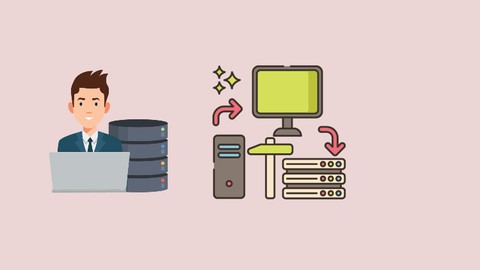
SQL Developer – T-SQL/SQL Server/SSMS/SSIS/ ETL,/SSRS/ SSAS
SQL Developer – T-SQL/SQL Server/SSMS/SSIS/ ETL,/SSRS/ SSAS, available at $39.99, has an average rating of 4, with 85 lectures, based on 13 reviews, and has 1030 subscribers.
You will learn about Explore data with SQL | TSQL Setup SQL Server Implement ETL | SSIS Solution Create tabular models with SSAS Connect to SQL Server with SSMS Create reports with SSRS Create and execute stored procedures This course is ideal for individuals who are Beginner SQL Developer It is particularly useful for Beginner SQL Developer.
Enroll now: SQL Developer – T-SQL/SQL Server/SSMS/SSIS/ ETL,/SSRS/ SSAS
Summary
Title: SQL Developer – T-SQL/SQL Server/SSMS/SSIS/ ETL,/SSRS/ SSAS
Price: $39.99
Average Rating: 4
Number of Lectures: 85
Number of Published Lectures: 85
Number of Curriculum Items: 85
Number of Published Curriculum Objects: 85
Original Price: $109.99
Quality Status: approved
Status: Live
What You Will Learn
- Explore data with SQL | TSQL
- Setup SQL Server
- Implement ETL | SSIS Solution
- Create tabular models with SSAS
- Connect to SQL Server with SSMS
- Create reports with SSRS
- Create and execute stored procedures
Who Should Attend
- Beginner SQL Developer
Target Audiences
- Beginner SQL Developer
SQL is a domain-specific language used in programming and designed for managing data held in a relational database management system, or for stream processing in a relational data stream management system.
T-SQL (Transact-SQL) is a set of programming extensions from Sybase and Microsoft that add several features to the Structured Query Language (SQL), including transaction control, exception and error handling, row processing and declared variables.
All applications that communicate with SQL Server do so by sending T-SQL statements to the server. T-SQL queries include the SELECT statement, selecting columns, labelling output columns, restricting rows and modifying a search condition.
T-SQL identifiers, meanwhile, are used in all databases, servers, and database objects in SQL Server. These include the following tables, constraints, stored procedures, views, columns and data types. T-SQL identifiers must each have a unique name, are assigned when an object is created and are used to identify an object.
SQL Server Integration Services is a component of the Microsoft SQL Server database software that can be used to perform a broad range of data migration tasks. SSIS is a platform for data integration and workflow applications. It features a data warehousing tool used for data extraction, transformation, and loading.
SQL Server Reporting Services is a server-based report generating software system from Microsoft. It is part of a suite of Microsoft SQL Server services, including SSAS and SSIS. Administered via a Web interface, it can be used to prepare and deliver a variety of interactive and printed reports.
Microsoft SQL Server Analysis Services is an online analytical processing and data mining tool in Microsoft SQL Server. SSAS is used as a tool by organizations to analyse and make sense of information possibly spread out across multiple databases, or in disparate tables or files.
A stored procedure is a subroutine available to applications that access a relational database management system. Such procedures are stored in the database data dictionary. Uses for stored procedures include data-validation or access-control mechanisms
Course Curriculum
Chapter 1: Environment Setup
Lecture 1: Introduction
Lecture 2: overview SQL Developer – T-SQL/SQL Server/SSMS/SSIS/ ETL,/SSRS/ SSAS
Lecture 3: What is SSIS
Lecture 4: What is ETL
Lecture 5: What is SSRS
Lecture 6: What is SSAS
Chapter 2: SQL Server Setup
Lecture 1: What is SQL Server
Lecture 2: SQL Server Editions
Lecture 3: SQL Server Installation Requirements
Lecture 4: Download SQL Server
Lecture 5: Install SQL Server
Lecture 6: Install SSMS
Lecture 7: Connect SSMS to SQL Server
Lecture 8: Install Sample Database
Chapter 3: Data Exploration with T-SQL | SQL
Lecture 1: What is T-SQL
Lecture 2: Create a database
Lecture 3: Data Preparation
Lecture 4: Importing Datasets
Lecture 5: How many continents do we have data for
Lecture 6: Possibility of dying from COVID
Lecture 7: Percent of population infected with COVID
Lecture 8: Countries with highest covid infection
Lecture 9: Countries with highest covid death
Lecture 10: Continents with highest covid deaths
Lecture 11: Global covid death
Lecture 12: Number of people vaccinated
Lecture 13: Query data with CTE
Lecture 14: Create temporary tables
Lecture 15: Create views
Chapter 4: Visual Studio Setup
Lecture 1: What is Visual Studio
Lecture 2: Visual studio installation requirements
Lecture 3: Visual Studio workloads
Lecture 4: Installing Visual Studio
Lecture 5: Installing SQL Server Data Tools
Lecture 6: Installing SSDT Designers for SSIS,SSRS,SSAS
Chapter 5: Implementing ETL | SSIS
Lecture 1: Create a new integration services project
Lecture 2: SSIS Designer
Lecture 3: Add and configure a flat connection manager
Lecture 4: Remapping column data types
Lecture 5: Add and configure OLE DB connection manager
Lecture 6: Add a data flow task to the package
Lecture 7: Add and configure the flat file source
Lecture 8: Add and configure the lookup transformations
Lecture 9: Add and configure lookup for datekey transformation
Lecture 10: Add and configure OLE DB Destination
Lecture 11: Test the package
Chapter 6: Creating Reports with SSRS
Lecture 1: Create a report server project
Lecture 2: Create a report definition file
Lecture 3: Configure a data source for the report
Lecture 4: Define a dataset for the report
Lecture 5: Add a table to the report
Lecture 6: Format the report
Lecture 7: Group data in the report
Lecture 8: Adding totals to the report
Lecture 9: Previewing the report
Lecture 10: Exporting the report
Chapter 7: SSAS – Create a Tabular Model
Lecture 1: Logon to SSAS
Lecture 2: Create a tabular model project
Lecture 3: Explore tabular model authoring
Lecture 4: Create connection to data source
Lecture 5: Transform and import data
Lecture 6: Mark as date table
Lecture 7: Create table relationships
Lecture 8: Creating calculated columns : part 1
Lecture 9: Creating calculated columns : part 2
Lecture 10: Creating measures : part 1
Lecture 11: Creating measures : part 2
Lecture 12: Creating measures : part 3
Lecture 13: Creating Key Performance Indicators
Lecture 14: Creating Perspectives
Lecture 15: Creating Hierarchies : Part 1
Lecture 16: Creating Hierarchies : Part 2
Lecture 17: What are partitions
Lecture 18: Creating partitions
Lecture 19: Creating Roles
Lecture 20: Analyse data in Excel
Lecture 21: Deploying your model
Lecture 22: Analysing Model
Chapter 8: SQL Stored Procedures
Lecture 1: Introduction to stored procedures
Lecture 2: Creating stored procedures
Lecture 3: Modifying Stored Procedures
Lecture 4: Properties page of a stored procedure
Lecture 5: Viewing dependencies of a stored procedure
Lecture 6: Viewing definition of a stored procedure
Lecture 7: Deleting a stored procedure.
Instructors
-
247 Learning
An investment in knowledge pays the best interest
Rating Distribution
- 1 stars: 1 votes
- 2 stars: 1 votes
- 3 stars: 3 votes
- 4 stars: 4 votes
- 5 stars: 4 votes
Frequently Asked Questions
How long do I have access to the course materials?
You can view and review the lecture materials indefinitely, like an on-demand channel.
Can I take my courses with me wherever I go?
Definitely! If you have an internet connection, courses on Udemy are available on any device at any time. If you don’t have an internet connection, some instructors also let their students download course lectures. That’s up to the instructor though, so make sure you get on their good side!
You may also like
- Best Investing Courses to Learn in March 2025
- Best Personal Finance Courses to Learn in March 2025
- Best Health And Wellness Courses to Learn in March 2025
- Best Chatgpt And Ai Tools Courses to Learn in March 2025
- Best Virtual Reality Courses to Learn in March 2025
- Best Augmented Reality Courses to Learn in March 2025
- Best Blockchain Development Courses to Learn in March 2025
- Best Unity Game Development Courses to Learn in March 2025
- Best Artificial Intelligence Courses to Learn in March 2025
- Best Flutter Development Courses to Learn in March 2025
- Best Docker Kubernetes Courses to Learn in March 2025
- Best Business Analytics Courses to Learn in March 2025
- Best Excel Vba Courses to Learn in March 2025
- Best Devops Courses to Learn in March 2025
- Best Angular Courses to Learn in March 2025
- Best Node Js Development Courses to Learn in March 2025
- Best React Js Courses to Learn in March 2025
- Best Cyber Security Courses to Learn in March 2025
- Best Machine Learning Courses to Learn in March 2025
- Best Ethical Hacking Courses to Learn in March 2025






















